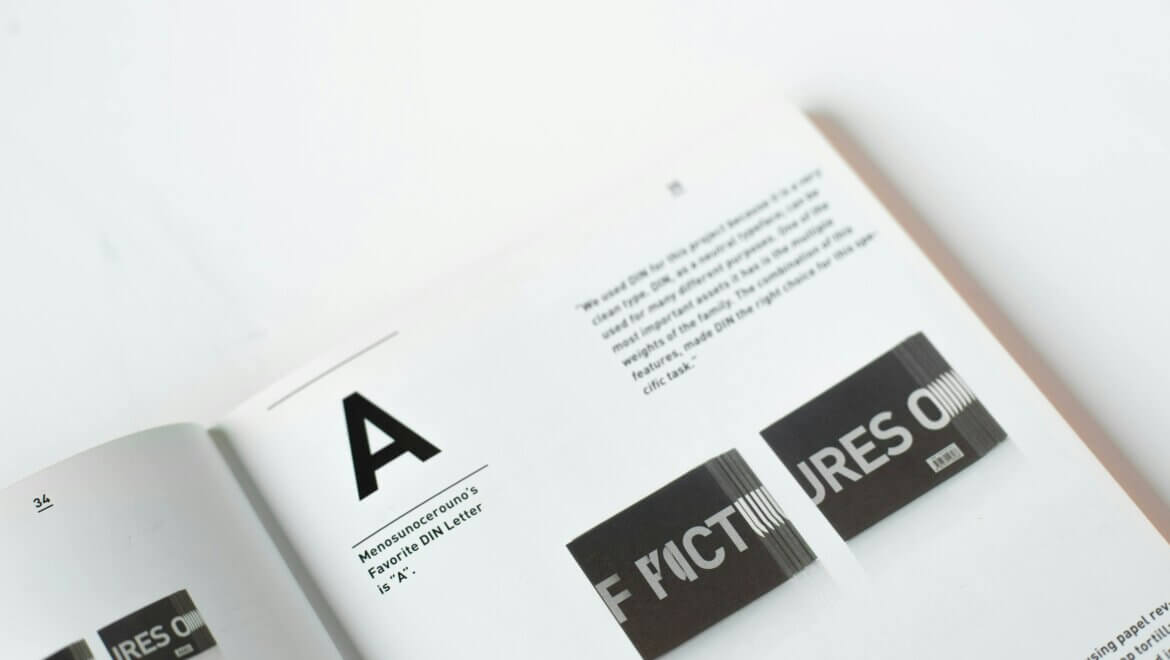Keeping things simple is frequently the best approach in design. The discussion of white space, often known as negative space, in relation to font usage accentuates this point. White space is more than an empty area. It’s an effective design tool that significantly improves the visual impact of your words. The absence of visual elements, such as text or pictures, helps the viewer in getting your intended meaning.
Picture yourself in a room full of people all chatting at once. It’s challenging to focus on a single voice. Let your mind travel to a peaceful library. Clear thinking and understanding are expected. That peaceful area is equivalent to white space in design. Your message will be more noticeable. It’s similar to the musical pauses that improve the overall tone of a song.
Effective use of white space can transform boring text into a captivating visual tale. As a result, large blocks of text become more readable and pleasant to the eye. The use of white space allows designers to guide the reader’s sight across the page, drawing attention to key elements and creating a sense of organization. In this approach, the key points of the message stand out.
In addition to improving readability and organization, white space has the power to create emotions and establish a tone. Having a lot of empty space around an object might give it a more refined, calming appearance. It might take on a more lively or even playful vibe with less white space. To carefully influence the audience’s perception and emotional response to the content, you might manipulate this apparently vacant area.
The topic of this article is on the various font-related uses of white space. Let’s take a look at how it may improve the appearance of words, make things simpler to read, highlight essential details, and even include specific emotions into your design. Designing with effective use of negative space allows you to fully use font choices, resulting in attractive and memorable pieces.
What is, exactly, white space in design, also known as negative space?
Essentially, white space is the empty space around design elements. It’s the blank sheet where all of your visual elements, such text and photos, will live. It is a basic error, however, to think of white space as nothing more than empty space. White space is not empty space. It is an active and vital part of design that shapes the whole visual experience and affects the power of your message’s communication. Clarity, structure, and the design’s emotional impact are all influenced by this dynamic force.
Consider empty space to be the design’s oxygen. White space, like a speaker pausing to emphasize, gives the viewer’s eye a break to relax and absorb information more effectively. It’s the white space that makes everything else pop, keeping things from getting too busy or excessive. Design stiffness and confusion occur when there isn’t enough white space for the viewer to concentrate and receive the content. White space, in its most basic definition, is not just empty space; it is an intentionally designed element that improves the composition as a whole.
There are several ways to classify white space, depending on its size and function. A design’s greater sections of unoccupied space are called macro white space. In this context, “white space” refers to places like page margins, website sections, and the spaces between main visual elements. A sense of openness is created and the different components are given room to breathe by the macro white space, which provides a central framework and structure for the design.
When it comes to spacing, though, micro white space is all about the little things. The leading space between lines of text, the border of space between letters, and the paragraph breaks are all part of this. Reading ability and legibility are greatly improved by these apparently minor changes. With the right amount of tiny white space, the text flows easily and pleasantly, making it easy for the reader to follow up. It determines whether reading is an enjoyable experience or a frustrating one.
Beyond these groups, white space can also be categorized according to its purpose. The purpose of active white space is to highlight certain parts of a design or to establish a visual hierarchy. It’s an intentional design decision that serves to direct the attention and highlight important details. In contrast, passive white space develops organically around elements and is frequently an outcome of design and content. Maintaining balance and avoiding an overloaded design are similarly encouraged by passive white space, even though it isn’t as deliberately planned as active white space. In order to create designs that are both functional and aesthetically pleasing, it is essential to understand the relationship between these many forms of white space.
How to effectively use white space with fonts?
The secret to making designs that are both readable and aesthetically pleasing is to use white space wisely with fonts. Line spacing, also called leading, is a crucial component. One of the most important factors in readability is the amount of white space between lines of text. When lines are too close together, it makes the text feel crowded and hard to read. But if they’re too far apart, the text could appear fragmented and disorganized. As a general guideline, you should strive for line spacing that is around 120-150% of the font size. This gives the reader’s eyes adequate space to glide from line to line without straining.
Tracking, the process of changing the spacing between individual letters, is another vital tool. Your writing will appear more polished and easier to read if you do this. Too close of a letter spacing makes the text difficult to read. The letters could appear to be floating if the spacing is too wide. Making small adjustments to this spacing can have a big impact on how your text looks. Kerning is a similar idea. It involves modifying the gap between certain letter pairs. For some letter combinations, such as “AV” or “WA”, the natural spacing can appear disproportionate, therefore this is essential. The outcome is more balanced and visually pleasing when the kerning is done carefully.
Paragraph spacing is very important, particularly for wider texts. Paragraphs are easier to read and understand when they are spaced apart. This allows the reader a little time to absorb what they’ve read before going on to the next section, much like pausing when you talk. You should also leave enough space around your text. The empty space around text on a screen or page is an important part of the composition as a whole. If the margins are large, the design will seem open and elegant, but if they are narrow, the design will seem crowded and rigid.
Having enough white space around headers and subheadings is also helpful. They stand out from the body text and establish an optical structure when given plenty of space surrounding them. This facilitates the reader’s ability to scan the page and assimilate the organization of the content. You can create visual interest and establish hierarchy by using varied font weights and sizes. However, be careful not to go crazy with the variations, since this can make the design look cluttered. Another factor is alignment. Text that is justified might give the impression of formality and organization, but left-aligned text tends to be more casual and easy to read. On the other hand, justified text has the potential to produce “rivers” of white space and uneven spacing, which might disrupt the reading flow.
Last but not least, consider the logos and brand’s white space. A lot of well-known logos make effective use of negative space to make a strong impression. For instance, in the subtle area between the “E” and “x.” of the FedEx logo, there is a concealed arrow. This shows how even in a little format, white space can make a design more meaningful and complex.
Common mistakes to avoid when using white space
While white space is a powerful design tool, it’s easy to make mistakes if you’re not careful. One of the most common ones is being afraid of empty space. However, if you aren’t cautious, white space may be a tremendous design technique gone wrong. Being terrified of nothingness is a typical problem. Too many people make the mistake of attempting to fit their design into every available space, which can backfire. Rather than seeing white space as empty, try viewing it as an active component that can elevate your design. Imagine it as providing some breathing space for your design.
Another common error is using irregular spacing. Make sure that the spacing between your design elements is uniform. Disorganized design is the result of inconsistent spacing, which is amateurish. Get a good spacing strategy going and don’t shift. The flip side is that white space can be overused. Even while it’s essential having too much can leave your design seeming unfinished and vacant. It is important to find a balance. Your design’s content and purpose should be complemented, not overshadowed, by the quantity of white space.
Another typical issue is disregarding the visual hierarchy. Using white space effectively establishes a visual hierarchy and leads the eye of the reader through the design. A composition that is both confused and unproductive can be the outcome of skipping this step. Use white space to draw attention to key points and provide a natural progression of ideas. And lastly, adaptability to mobile devices should not be overlooked. Make sure the white space is tailored for different screen sizes so that your design looks excellent on all devices. Even if the design is crisp and clear on a desktop computer, it may be too busy and hard to read on a mobile device.
Just like any other design element, white space plays a crucial role in how effective your font is. You may make designs that are easy on the eyes and the brain if you study its principles and put them to smart use. Always keep in mind that white space is more than meets the eye; it is a powerful design element that may improve readability, establish visual hierarchy, and even elicit emotions. Make good use of it to elevate your typography skills.
Choosing the right fonts and making good use of white space are the two most important aspects of good design. A striking and balanced visual experience can be achieved with the correct font and with careful use of white space. More white space may be necessary for a minimalist font to stand out, but a bolder, more ornamental font may look better with less. It is critical to get the right font to go with your white space plan. If you come across a minimalist font that you really like but don’t know its name, WhatFontIs.com is a great place to look.
In a matter of seconds, this reliable tool can recognize almost any typeface. All you have to do is take a screenshot of the text using the font you want, and our advanced search algorithms will find it for you. Then you can easily use it in your own projects. You may make typographic compositions that stand out by giving thoughtful consideration to white space and font choice. White space and font choice are two aspects of typography that can help you create eye-catching compositions.



